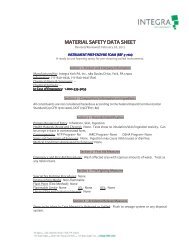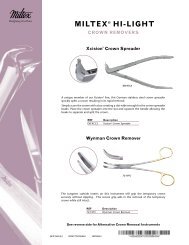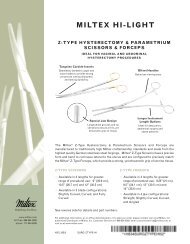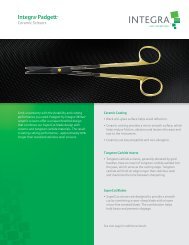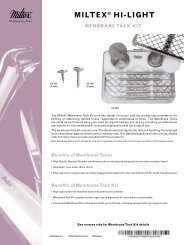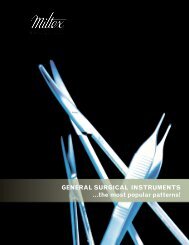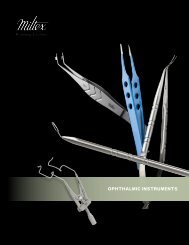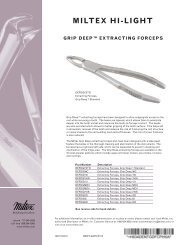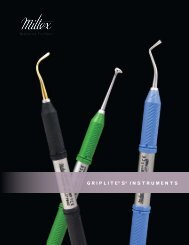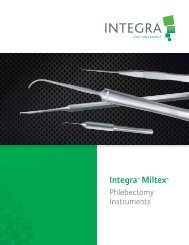Catalog - Hygiene - Integra Miltex
Catalog - Hygiene - Integra Miltex
Catalog - Hygiene - Integra Miltex
You also want an ePaper? Increase the reach of your titles
YUMPU automatically turns print PDFs into web optimized ePapers that Google loves.
I n s t r u m e n t C A R E I N S T R U C T I O N S<br />
C l e a n i n g, S t e r I L I z at i o n & M a i n t e n a n c e o f I n s t r u m e n t s<br />
1. HOLDING/PRESOAK<br />
Never hold instruments in a dry container. Doing so allows<br />
blood and debris to dry onto instrument surfaces and makes<br />
cleaning more difficult. If rinsing and decontamination processes<br />
are not immediately available, pre-treat instruments or<br />
hold them in a neutral pH holding/presoak enzymatic solution<br />
after patient use but before actual cleaning. <strong>Miltex</strong> ® Instrument<br />
Prep Enzyme Foam (3-760) is a ready to use foaming spray for<br />
pre-cleaning soiled instruments and scopes. Simply spray the<br />
foam on instruments until they are ready for processing. Also,<br />
<strong>Miltex</strong> ® EZ-Zyme ® (3-750 and 3-755) neutral pH all purpose<br />
multi-enzyme concentrate is ideal for instrument presoaking<br />
and pre-cleaning. As soon as possible, rinse and clean as follows:<br />
2. RINSING<br />
(Always wear safety protection gear.) Immediately after surgery,<br />
remove organic materials by rinsing instruments under<br />
warm (120° F) running water. Rinse should remove most blood,<br />
fluids and tissue. Do not process dissimilar metals (stainless,<br />
copper, chrome plated, etc.) together.<br />
Note: Disinfection can be included to protect medical personnel<br />
from contamination during cleaning; however, protection also<br />
can be accomplished by following standard precautions by wearing<br />
appropriate PPE as promulgated by OSHA & AORN.<br />
3. CLEANING<br />
All blood, dried body fluids and tissue should be completely<br />
removed from instruments prior to sterilization. Several<br />
methods for removing these materials are available.<br />
A. Soak: An enzymatic cleaner bath (soak) such as<br />
<strong>Miltex</strong> ® EZ-Zyme ® (3-750 and 3-755) or a solution of<br />
water and neutral pH (7) detergent such as <strong>Miltex</strong> ®<br />
Surgical Instrument Cleaner (3-720, 3-725 and 3-726)<br />
is effective in removing organic material from<br />
instruments. Use distilled (demineralized) water, if<br />
possible. Instruments should be fully submerged for<br />
at least 10 minutes. Do not let “sharps” (scissors,<br />
knives, osteotomes, etc.) touch each other. Ensure<br />
that dissimilar metal instruments are separated.<br />
Rinse instruments under running water to remove<br />
solutions and change solutions frequently.<br />
B. Ultrasonic Cleaning: Most instrument<br />
manufacturers recommend ultrasonic cleaning as the<br />
most effective way to clean surgical instruments,<br />
particularly instruments with hinges, box locks and<br />
other moving parts.<br />
• All instruments must be fully submerged in an open<br />
position using distilled (demineralized) water, if<br />
possible. To prevent possible surface scratching make<br />
sure that “sharps” do not touch other instruments.<br />
Also, separate instruments of dissimilar metals.<br />
• Process instruments for the full recommended<br />
ultrasonic cleaning cycle. Change solution frequently<br />
or as often as the manufacturer recommends.<br />
• Rinse instruments with water to remove the cleaning<br />
solution. <strong>Miltex</strong> ® EZ-Zyme ® (3-750 and 3-755) or <strong>Miltex</strong> ®<br />
Surgical Instrument Cleaner (3-720, 3-725 and 3-726)<br />
can be safely used with all ultrasonic units.<br />
C. Automatic Washer Sterilizers: Following manufacturers’<br />
recommendations, ensure that instruments are lubricated<br />
before the sterilization cycle and after the last rinse cycle.<br />
CAUTION: Needle holders and forceps may crack if sterilized<br />
with ratchet in closed position.<br />
D. Manual Cleaning: If ultrasonic cleaning is not available,<br />
observe the following steps:<br />
• Use stiff nylon cleaning brushes (3-1000). Do not use steel<br />
wool or wire brushes except stainless steel wire brushes<br />
(3-1001) specially recommended for instrument serrated<br />
areas, bone files, burs or on stained areas of knurled handles.<br />
• Use only neutral pH (7) detergents such as <strong>Miltex</strong> ® Surgical<br />
Instrument Cleaner (3-720, 3-725 and 3-726). If not rinsed off<br />
properly, low pH (acidic - less than 6 pH) detergents break<br />
down the stainless protective surface resulting in pitting<br />
and/or black staining on instruments. High pH detergents<br />
(alkaline - more than 8 pH) can cause brown stains<br />
(phosphate surface deposit) which can also interfere with<br />
the smooth operation of instruments. Most brown stains are<br />
not rust and are easily removed with <strong>Miltex</strong> ® Surgical<br />
Instrument Stain Remover (3-740).<br />
• Brush delicate instruments carefully, and if possible,<br />
separate them from general instruments.<br />
• Make sure instrument surfaces are visibly clean and are<br />
free from stains and tissue. <strong>Miltex</strong> ® Surgical Instrument<br />
Stain Remover (3-740) can help remove residue stains. This<br />
is also a good time to inspect each instrument for proper<br />
function and condition.<br />
• Check scissors’ blades to ensure proper function.<br />
Blades should open and close smoothly. Test cutting<br />
performance at 3/4 length of the blade with the materials<br />
recommended below. Scissors should cut all the way<br />
to the tips. Recommended cutting test materials:<br />
– Fine/Delicate scissors: Surgical glove<br />
– Medium scissors: Single layer of stocking/cast netting<br />
– Large/Utility scissors: Double layer of stocking/cast<br />
netting<br />
• Check forceps (pickups) for proper jaw alignment. Teeth<br />
must meet properly without catching.<br />
• Check hemostats and needle holders to ensure jaw tips<br />
close in first ratchet position and that the entire jaw<br />
closes in third ratchet position. Check instruments<br />
for loose hinges and verify that they lock and unlock easily.<br />
Also check instruments for wear on jaw surfaces.<br />
• Suction tubes should be clean inside.<br />
• Test Biopsy Punches by punching a clean hole in<br />
3-6 mil thick poly-bag material. If poly-bag material is<br />
not available, use tissue paper.<br />
• Retractors should function properly.<br />
www.miltex.com<br />
67



